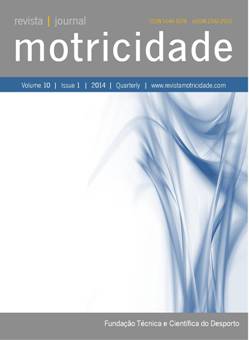Match analysis on Football: Metrics to evaluate the collective behavior
DOI:
https://doi.org/10.6063/motricidade.1517Abstract
In the last few years, the collective analysis in football teams has been focused on their complex reality. This study aimed to propose 4 collective metrics based on the spatio-temporal relationship, trying to identify differences between the moments with and without ball possession. A U14 7-a-side football match was analysed. Significant differences were found between the moments with and without ball possession regarding the space covered by team A (F(1, 1506)= 8.31, p= 0.004, η²= 0.005, Power= 0.82) and B (F(1, 1506)= 37.66, p= 0.001, η²= 0.024, Power= 1.00), effective area of play on team A (F(1, 1506)= 1343.89, p= 0.001, η²= 0.472, Power= 1.000) and B (F(1, 1506)= 968.50, p= 0.001, η²= 0.391; Power= 1.00), as well as at centroid position for team A (F(1. 1506)= 11.79, p= 0.001, η²= 0.008, Power= 0.93) and B (F(1, 1506)= 9.43, p= 0.001, η²= 0.006, Power= 0.87). As a conclusion, it was possible to analyse the spatio-temporal relationship between teammates, identifying expansion behaviour with ball possession, as well as a centroid progression at the field with the collective metrics selected.
Downloads
Published
Issue
Section
License
The authors of submitted manuscripts must transfer the full copyright to Journal Motricidade / Desafio Singular Editions. Granting copyright permission allows the publication and dissemination of the article in printed or electronic formats and copyrights start at the moment the manuscript is accepted for publication. It also allows Journal Motricidade to use and commercialize the article in terms of licensing, lending or selling its content to indexation/abstracts databases and other entities.
According to the terms of the Creative Commons licence, authors may reproduce a reasonable number of copies for personal or professional purpose but without any economic gains. SHERPA/RoMEO allows authors to post a final digital copy (post-printing version) of the article in their websites or on their institutions' scientific repository.


